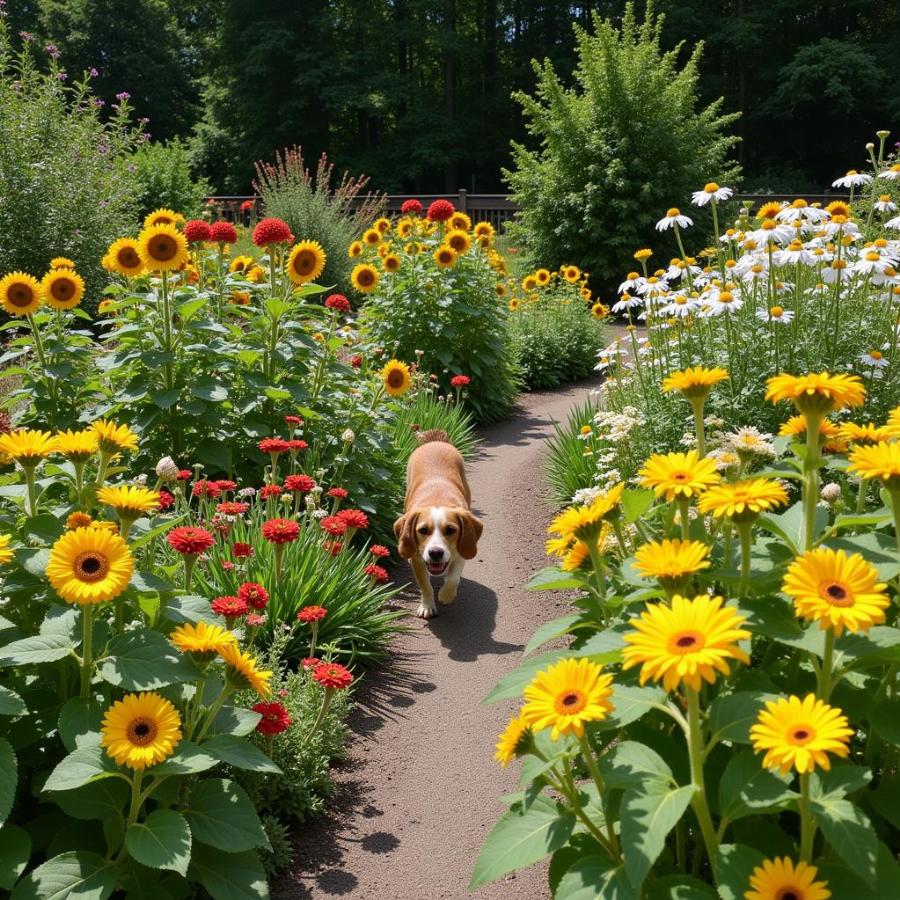Dogs and plants can coexist beautifully, adding life and vibrancy to your home. However, it’s essential to be mindful of potential hazards. Some common houseplants and garden varieties are toxic to dogs, posing risks ranging from mild irritation to severe illness. This comprehensive guide will explore how to create a dog-friendly garden, identify toxic plants, and respond to potential poisoning. Let’s delve into the world of dogs and plants, ensuring the safety and happiness of both.
What do people want to know when they search for “dog with plant”? They are likely looking for information on plant toxicity for dogs, how to keep dogs away from plants, or maybe even inspiration for pet-friendly landscaping. They might be concerned about their dog’s safety after noticing them nibbling on a houseplant or digging in the garden. They want peace of mind, knowing their furry friends are safe in their green surroundings. Understanding this helps us provide the most relevant and helpful information.
Creating a Dog-Friendly Garden
Having a dog doesn’t mean sacrificing your green thumb. With careful planning, you can cultivate a vibrant garden that’s both beautiful and safe for your canine companion. Choosing non-toxic plants is the first step, but also consider creating designated dog zones. This could be a specific area with dog-friendly ground cover, or simply fencing off delicate plants.
What plants are safe for dogs? There are many wonderful options! Sunflowers, zinnias, and snapdragons add pops of color and are generally safe. For ground cover, consider clover or chamomile. Remember to research any plant before introducing it to your dog’s environment.
 Dog-Friendly Garden Ideas with Safe Plants
Dog-Friendly Garden Ideas with Safe Plants
Protecting Your Plants from Your Dog
Even with non-toxic plants, some dogs just love to dig or chew. Here are some tips to protect your prized greenery:
- Training: Consistent training is key. Teach your dog commands like “leave it” and “drop it” to deter them from interacting with plants.
- Physical Barriers: Fencing, chicken wire, or decorative rocks can create barriers around vulnerable plants.
- Deterrents: Citrus sprays or commercially available dog deterrents can discourage chewing and digging.
- Provide Alternatives: Offer dog-friendly chew toys and designated digging areas to redirect their energy.
Identifying Toxic Plants
Many seemingly harmless plants can be hazardous to dogs. Here are some of the most common culprits:
- Lilies: Highly toxic, even small amounts can cause kidney failure in cats and certain varieties can be harmful to dogs as well.
- Sago Palms: All parts of this plant are poisonous, especially the seeds.
- Tulips and Hyacinths: The bulbs contain toxins that can cause vomiting, diarrhea, and even heart problems.
- Azaleas and Rhododendrons: These beautiful flowering shrubs can cause vomiting, weakness, and even coma.
Recognizing the Signs of Plant Poisoning
If your dog ingests a toxic plant, watch for these signs:
- Vomiting
- Diarrhea
- Loss of appetite
- Lethargy
- Excessive drooling
- Tremors or seizures
If you suspect your dog has been poisoned, contact your veterinarian or the ASPCA Animal Poison Control Center immediately.
What to Do if Your Dog Eats a Plant
Swift action is crucial if you suspect plant poisoning. Here’s what you should do:
- Identify the Plant: If possible, take a sample of the plant with you to the veterinarian.
- Contact Your Veterinarian: Inform them of the situation and follow their instructions.
- Do Not Induce Vomiting: Unless directed by a veterinarian, do not induce vomiting as this can sometimes worsen the situation.
Living Harmoniously with Dogs and Plants
With a little knowledge and preparation, dogs and plants can peacefully coexist. By carefully selecting plants, implementing preventative measures, and knowing how to respond to emergencies, you can create a vibrant and safe environment for both. Remember, a proactive approach is the best way to ensure the well-being of your furry friend and the beauty of your green spaces. Is your garden truly dog-safe?
FAQ
- What are some dog-friendly indoor plants? Spider plants, prayer plants, and certain ferns are generally safe for dogs.
- How can I keep my dog from digging in my garden? Provide a designated digging area and use deterrents like citrus sprays.
- What is the most toxic plant for dogs? Lilies are among the most toxic, posing a serious threat to a dog’s health.
- What are the signs of plant poisoning in dogs? Vomiting, diarrhea, lethargy, and loss of appetite are common signs.
- What should I do if my dog eats a poisonous plant? Contact your veterinarian or the ASPCA Animal Poison Control Center immediately.
- Can I use fertilizers in a dog-friendly garden? Choose pet-safe fertilizers and apply them according to instructions.
- Are there any apps that can help me identify toxic plants? Yes, several apps are available to help identify plants and determine their toxicity.
Related Articles You Might Find Helpful
- is christmas cactus plant poisonous to dogs This article provides detailed information on the toxicity of Christmas cacti for dogs.
- can dogs eat sweet plantains Learn about the safety of plantains for canine consumption in this informative piece.
Beaut Dogs is your one-stop resource for all things dog-related. We are dedicated to providing expert advice and helpful tips for dog owners. For further assistance or personalized recommendations, please contact us via Email: [email protected]. We’re happy to help! Beaut Dogs is committed to empowering dog owners with the knowledge they need to provide the best possible care for their furry companions.